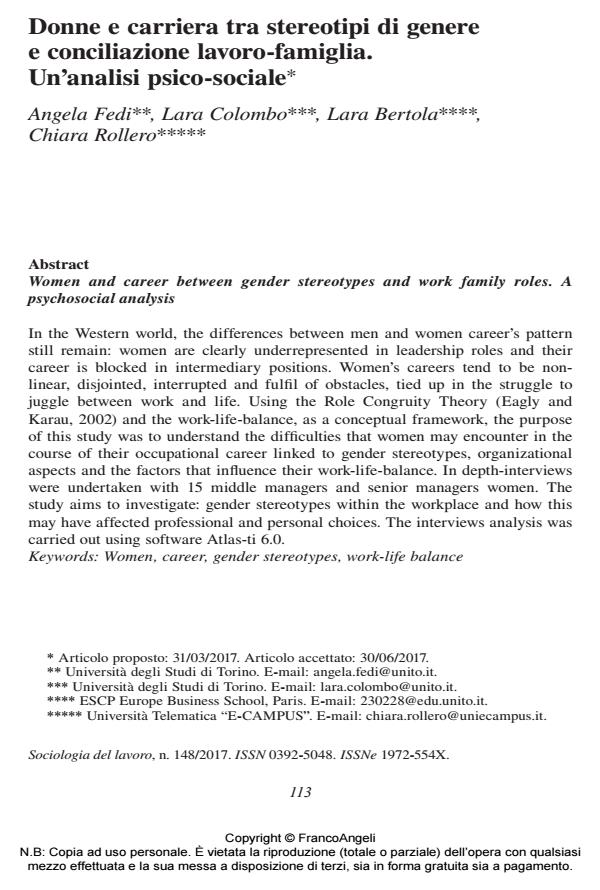Donne e carriera tra stereotipi di genere e conciliazione lavoro-famiglia. Un’analisi psico-sociale
Titolo Rivista SOCIOLOGIA DEL LAVORO
Autori/Curatori Angela Fedi, Lara Colombo, Lara Bertola, Chiara Rollero
Anno di pubblicazione 2017 Fascicolo 2017/148
Lingua Italiano Numero pagine 21 P. 113-133 Dimensione file 138 KB
DOI 10.3280/SL2017-148007
Il DOI è il codice a barre della proprietà intellettuale: per saperne di più
clicca qui
Qui sotto puoi vedere in anteprima la prima pagina di questo articolo.
Se questo articolo ti interessa, lo puoi acquistare (e scaricare in formato pdf) seguendo le facili indicazioni per acquistare il download credit. Acquista Download Credits per scaricare questo Articolo in formato PDF

FrancoAngeli è membro della Publishers International Linking Association, Inc (PILA)associazione indipendente e non profit per facilitare (attraverso i servizi tecnologici implementati da CrossRef.org) l’accesso degli studiosi ai contenuti digitali nelle pubblicazioni professionali e scientifiche
Nel mondo occidentale le disparità dei percorsi di carriera tra donne e uomini persistono ancora: le posizioni di status più elevato rimangono una prerogativa maschile, le donne sono invece bloccate in posizioni intermedie, presentando percorsi di carriera accidentati e caratterizzati da difficoltà, legate in gran parte all’equilibrio lavoro-resto della vita. Nel quadro teorico della Role Congruity Theory di Eagly e Karau (2002) e della conciliazione, la presente ricerca intende approfondire, attraverso interviste in profondità, la narrazione di 15 donne in posizioni lavorative di responsabilità. Nello specifico, lo studio intende indagare: il ruolo degli stereotipi di genere che hanno influenzato i percorsi di carriera e i vissuti di conciliazione lavoro-resto della vita e come questi hanno condizionato le scelte personali e professionali. Le interviste sono state sottoposte ad analisi del contenuto con l’ausilio di Atlas-ti 6.0.
Parole chiave:Donne, carriera, stereotipi di genere, famiglia-lavoro balance
- Are work–life policies fair for a woman’s career? An Italian qualitative study of the backlash phenomenon Lara Bertola, Lara Colombo, Angela Fedi, Mara Martini, in Gender in Management: An International Journal
/2023 pp.1
DOI: 10.1108/GM-12-2021-0366
Angela Fedi, Lara Colombo, Lara Bertola, Chiara Rollero, Donne e carriera tra stereotipi di genere e conciliazione lavoro-famiglia. Un’analisi psico-sociale in "SOCIOLOGIA DEL LAVORO " 148/2017, pp 113-133, DOI: 10.3280/SL2017-148007